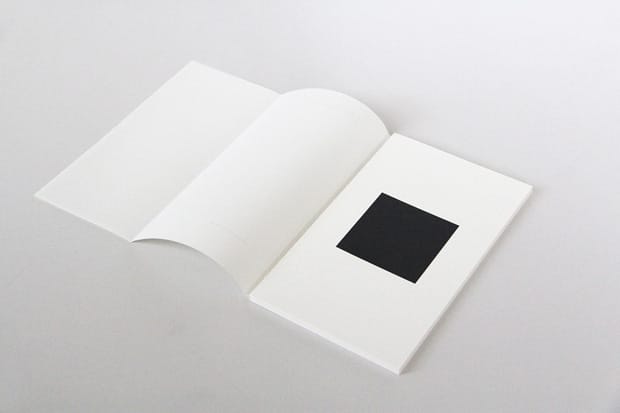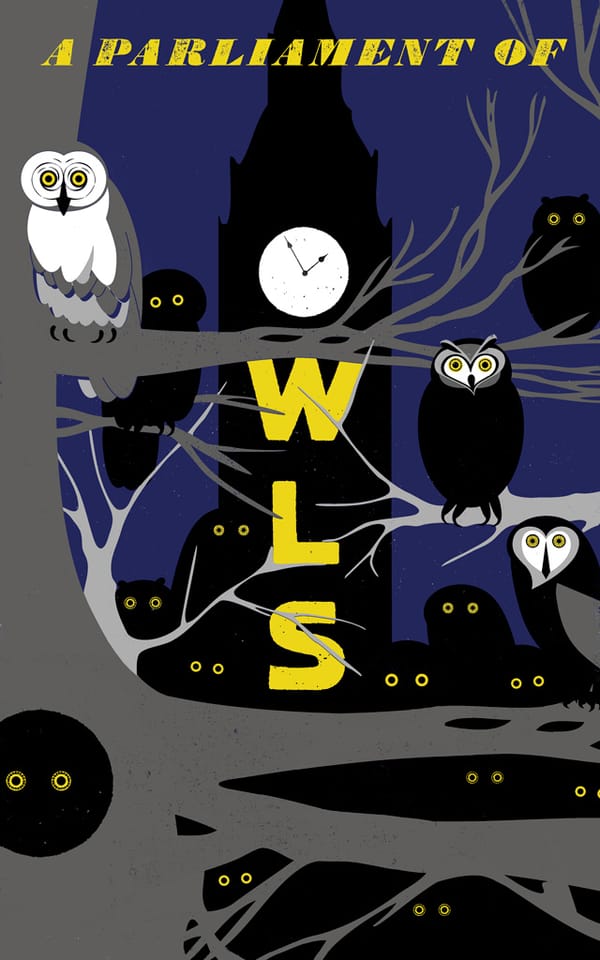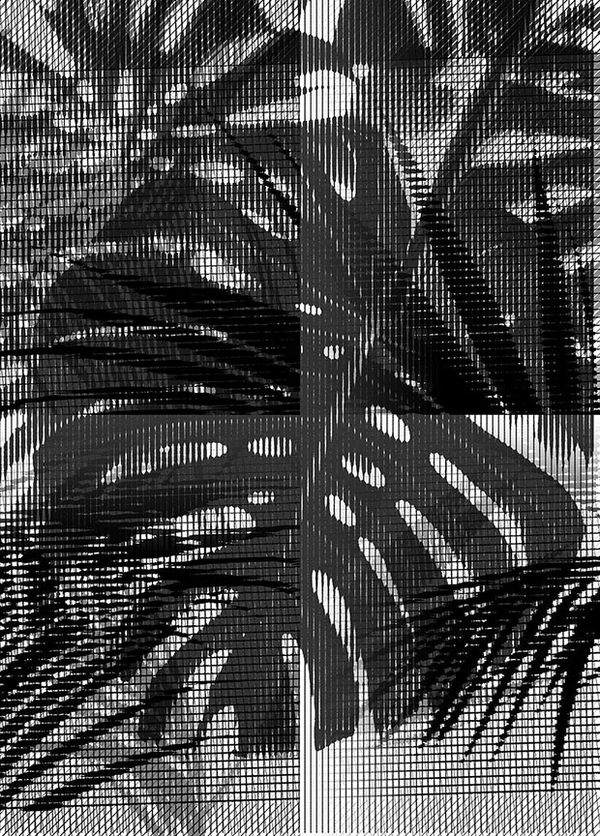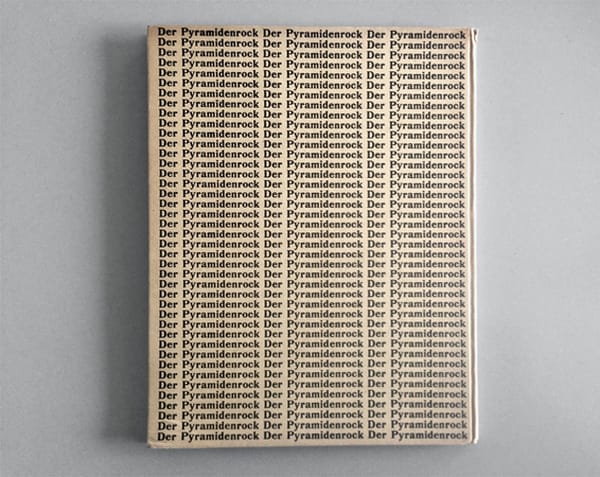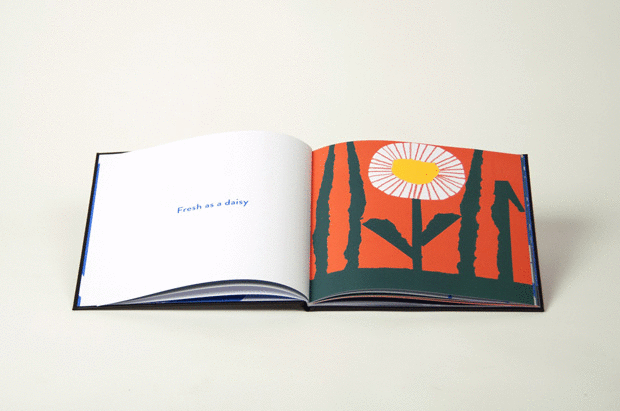Vienna-based designer and typographer Paulus Dreibholz has published a beautiful volume all about that fundamental human activity, reading. We are delighted to publish an exclusive extract...
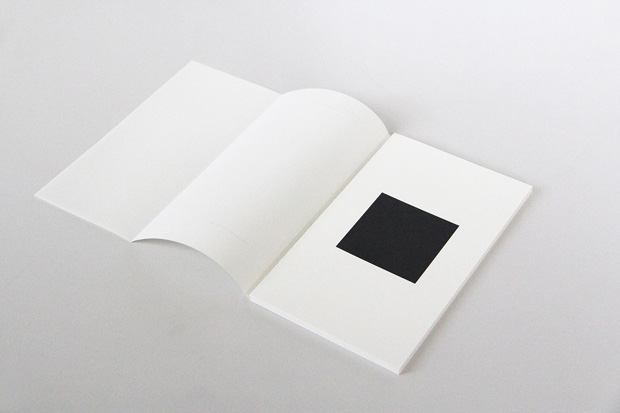
Introduction
Along with music, architecture, literature, acting, dance and other cultural activities, typography claims only a small niche in the totality of human communication and interaction. However, due to its direct relationship to language, its complexity and ubiquity, its influence on our society and our society’s consciousness and development, typography constitutes an interesting and significant element of social life.
Typography is a wholly cultural phenomenon. Invented and refined by human beings, moulded to their needs and developed by their interaction with it, typography allows people to communicate across space and time. Typography cultivates and is cultivated: we form it and it (in)forms us.
Although man-made, typography is not exclusively based on learned, abstract knowledge: its influence and strength draw on our innate abilities to perceive and read. The purpose of the following text is to recall these skills, to make them conscious once again, with the ultimate goal of turning them into tools that designers can actively use in their work.
The following text was written for the student of typography and graphic design, and many of the situations addressed will seem familiar to him or her – at least to a certain extent. However, most of these thoughts are likely to be of interest to designers of all kinds and with different levels of experience, as they are also visible in and applicable to other domains, being essentially based on archetypal principles.
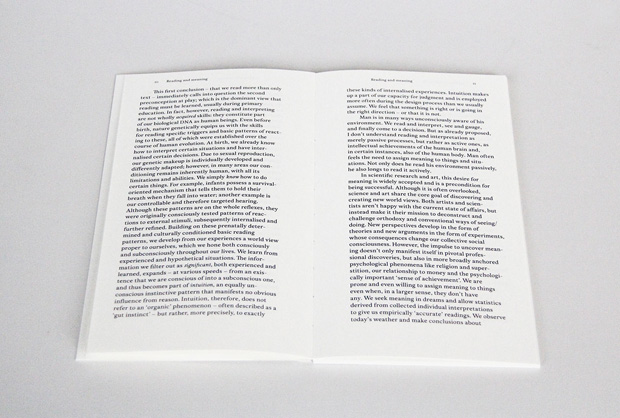
Though few, the fundamental questions discussed here come up nearly automatically during the process of designing; they are part of a designer’s daily work. Reading and meaning, the interpretation of image and form, text, typographical legibility and readability, the order of elements and their formal relationships: the designer addresses and sifts through these and other themes to find solutions for the problems posed to him and – by so doing – co-develops both his environment and his professional field. This iterative process constitutes the first – and more obvious –
level of a designer’s engagement in his work. It is, however, important to become conscious of the general frameworks for such problems, or preferably, to make them conscious, because to work without critical reflection is a lost opportunity to better understand oneself and one’s environment. To confront and consciously address these themes, to devote the necessary additional attention to them and to continue to critically engage with working processes constitutes the second level of designing: a level that rarely reveals itself, a level we – as designers – must actively seek out, and for which the following essay makes a case.
One way to come closer to this level is to read or write about design, to take the time for reflection. Another is to expose your own perspective to the thoughts and critique of colleagues, and thus to challenge and sharpen your own opinions through informal peer review. To tackle head-on the questions of fellow explorers and students, and to be ready to venture with them into uncharted waters, is yet another route.
In this spirit, I would like to dedicate this book to all of my fellow travellers, who shied away neither from wracking their brains with me nor retreated from the often heated discussions that sometimes ensued – often without generating any earth-shattering new points of view, though, at times, offering up new insights.
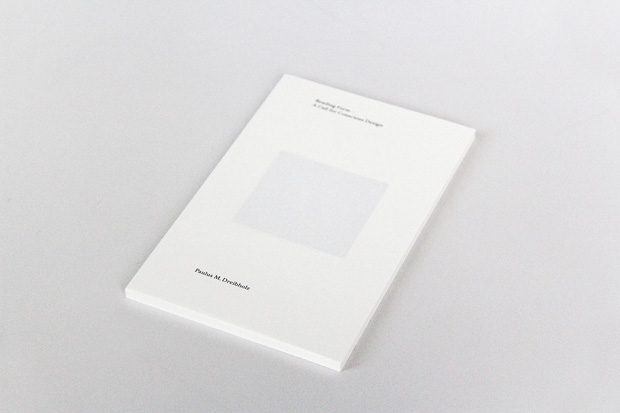
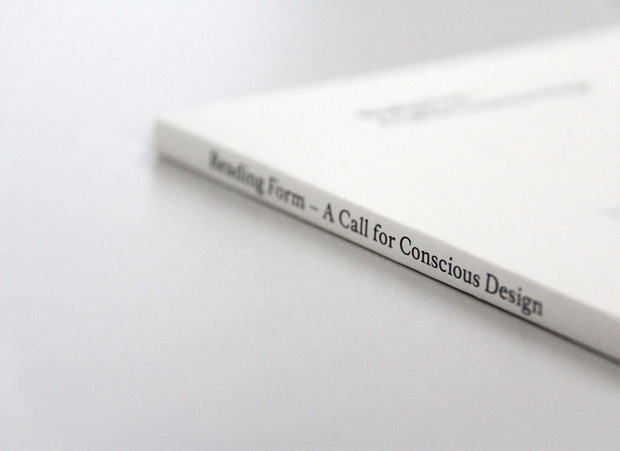
Reading and meaning
One of the most striking characteristics of human beings, and probably the biggest difference between humans and animals, is humans’ developed ability to communicate. The exchange of information – whether real or hypothetical, whether within ourselves or with others – allows us to establish distance between our being and our thoughts, and makes it possible to expand our consciousness in new ways. There is no such thing as communication without meaning (since even meaningless communication is open to interpretation). As a reciprocal process, however, communication begins first with the reading of meaning and not with the sending of information. Only when something has meaning can I see it, try to understand it and accordingly construct my own message. Because of this, I believe it makes sense to consider first the process of reading and to return to the process of design later.
The ability to recognise meaning and allocate it correctly is the basic requirement of semiotics, the study of meaning generally, and thus also of semantics, the linguistic study of meaning. Without this capacity to interpret there would be no meaning, no content to messages and no sense; only formal relationships and empty constructions containing neither purposeful nor coincidental relevance would exist. Meaning arises during the processes of reading, in particular the processes of acquiring and interpreting information. Let us examine the misunderstandings that result from two often prematurely drawn conclusions with regards to this process. The first preconception deals with the relationship between the reader and the word.
In conventional use, we take the written word as a precondition for the process of ‘reading’, and with that we leap directly to typography, the study of the printed word. This is, however, a premature connection, since reading encompasses more than the reading of letters. The verb ‘to read’ is the root for many characteristic modifications, as in ‘a reading’ or ‘the reader’. And, indeed, reading refers to the processing of more than only the written message. (The term ‘literacy’, incidentally, also alludes to media in general and not only to typographic messages, just as texts and other written messages, works of art, experiences and developments can also be read.) This broader definition of reading is not exclusive to the English language: in German, one also speaks, for example, of reading traces or tracks (Spurenlesen), likewise activities that have nothing to do with the written word.
But what exactly does it mean to read, to decipher or to interpret? What processes do we set in motion, which of these are automatically triggered: what happens to us when we read?
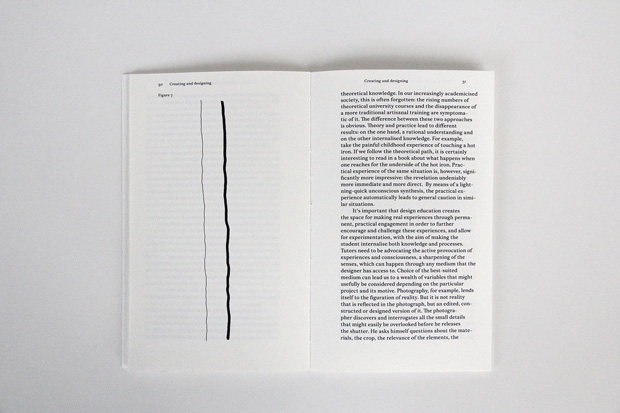
In a narrower sense, reading refers to the activity of absorbing information through one or more of our five senses. In a wider sense, reading also includes the process of interpretation, which I consider to be an active human engagement with the data received. In the process of interpreting, the reader transforms and appropriates sensory input into information that becomes relevant for him, his environment and his further decisions. Thus a middle step arises between input and meaning. Of course, both processes, reading and interpreting, are not always consciously experienced, let alone controlled: but they are permanently active and responsible for a large number of our actions.
This first conclusion – that we read more than only text – immediately calls into question the second preconception at play; which is the dominant view that reading must be learned, usually during primary education. In fact, however, reading and interpreting are not wholly acquired skills: they constitute part of our biological DNA as human beings. Even before birth, nature genetically equips us with the skills for reading specific triggers and basic patterns of reacting to these, all of which were established over the course of human evolution. At birth, we already know how to interpret certain situations and have internalised certain decisions. Due to sexual reproduction, our genetic makeup is individually developed and differently adapted; however, in many areas our conditioning remains inherently human, with all its limitations and abilities. We simply know how to do certain things. For example, infants possess a survival-oriented mechanism that tells them to hold their breath when they fall into water; another example is our controllable and therefore targeted hearing. Although these patterns are on the whole reflexes, they were originally consciously tested patterns of reactions to external stimuli, subsequently internalised and further refined. Building on these prenatally determined and culturally conditioned basic reading patterns, we develop from our experiences a world view proper to ourselves, which we hone both consciously and subconsciously throughout our lives. We learn from experienced and hypothetical situations. The information we filter out as significant, both experienced and learned, expands – at various speeds – from an existence that we are conscious of into a subconscious one, and thus becomes part of intuition, an equally unconscious instinctive pattern that manifests no obvious influence from reason. Intuition, therefore, does not refer to an ‘organic’ phenomenon – often described as a ‘gut instinct’ – but rather, more precisely, to exactly these kinds of internalised experiences. Intuition makes up a part of our capacity for judgment and is employed more often during the design process than we usually assume. We feel that something is right or is going in the right direction – or that it is not.
Man is in many ways unconsciously aware of his environment. We read and interpret, see and gauge, and finally come to a decision. But as already proposed, I don’t understand reading and interpretation as merely passive processes, but rather as active ones, as intellectual achievements of the human brain and, in certain instances, also of the human body. Man often feels the need to assign meaning to things and situations. Not only does he read his environment passively, he also longs to read it actively.
In scientific research and art, this desire for meaning is widely accepted and is a precondition for being successful. Although it is often overlooked, science and art share the core goal of discovering and creating new world views. Both artists and scientists aren’t happy with the current state of affairs, but instead make it their mission to deconstruct and challenge orthodoxy and conventional ways of seeing/doing. New perspectives develop in the form of theories and new arguments in the form of experiments, whose consequences change our collective social consciousness. However, the impulse to uncover meaning doesn’t only manifest itself in pivotal professional discoveries, but also in more broadly anchored psychological phenomena like religion and superstition, our relationship to money and the psychologically important ‘sense of achievement’. We are prone and even willing to assign meaning to things even when, in a larger sense, they don’t have any. We seek meaning in dreams and allow statistics derived from collected individual interpretations to give us empirically ‘accurate’ readings. We observe today’s weather and make conclusions about tomorrow’s. These and many other examples point to a desire to interpret, an internal impulse to see relevance and, when necessary, to produce it.
This desire to interpret is the precondition for a process that I will call relative reading. Relative reading can be seen as an extension of absolute reading, since the reader reads not only absolute values in the form of isolated facts or other closed realities, but interprets situations in their entirety, and processes them relative to the context in which he experiences them and according to his own background.
In a typographic context, when reading a text, the reader assigns meaning not only based on the linguistically defined content (words and sentences), but also based on the relationships between the visual marks, the forms that make these up, and between them and their context. Although this phenomenon happens in the reading of letters, it originated in the reading of natural occurrences. A herring is only small so long as it is seen in a human context, but for plankton the very same herring is a monster. In a more abstract example, a small black surface on a larger white one can call up a great variety of meanings not only by means of its size, but also depending on its position.
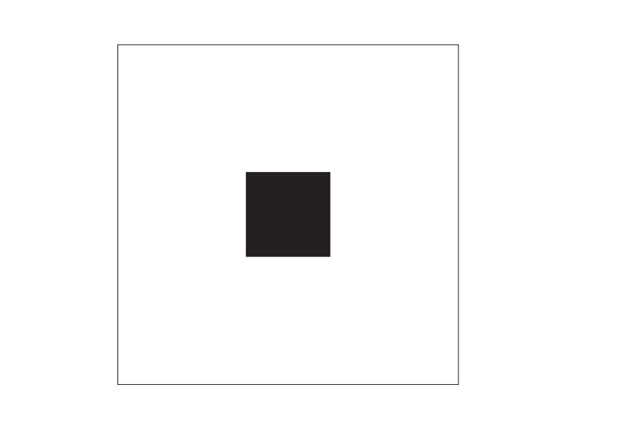
The black surface can sit comfortably in the middle, but can also build relationships to the borders of the canvas it is placed on. By changing its relative size in relation to its environment, the black surface can also generate an oppressive mood or create a frame.
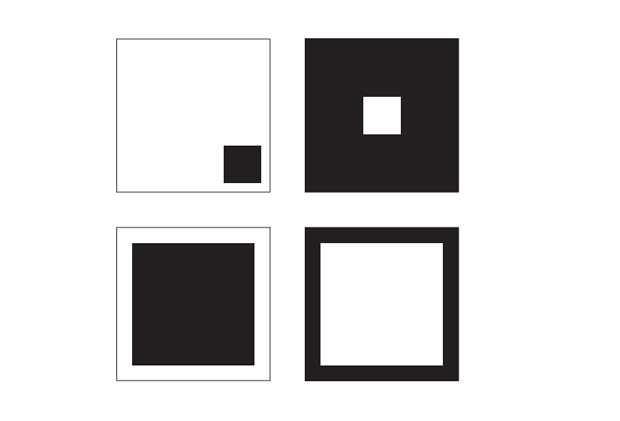
The same process in the opposite colours produces, in contrast, other (although not opposite) relations, and, depending on whether we sympathise with the white or the black surface, the meaning changes.
Optical illusions can occur as by-products of relative reading. Thus, for example, we interpret two circles of the same size differently according to their environments.
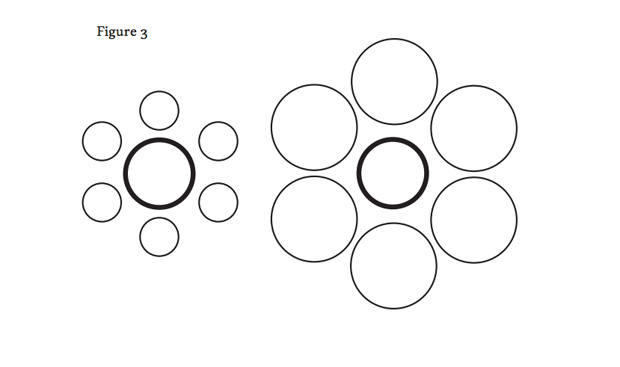
The consequence of these observations for the designer is that he must not only be aware of the absolute characteristics of the elements he uses, but also of their relative ones – the environment he places them in, the spaces between these elements, their visual connections and separations.
A comparison to music, in which I liken visual elements with the sounds of instruments, makes the general validity of this conclusion clear. An absolute reading of music would mean that each tone of an instrument is perceived by itself at a specific pitch and volume. In graphic design, this would correspond to an unpositioned (but still defined) black surface. In contrast, relative reading ‘hears’ the tone in a sequence with other tones of various volumes and in combination with other instruments. In this way, relative reading sees the surface in relation to its background. The eye draws connections to other graphic elements, reads letters as certain forms or glyphs in combination with others, and ultimately perceives them as the linguistic and formal carriers of meaning: the word.
To maintain the analogy and to explain the complexity of a visual message, I allow myself to place it next to a piece of classical music. Just as the composer who makes use of all the instruments in his opera to enable the soprano to find just the right expression, the graphic designer similarly assigns all the elements of his work to various roles, which together pursue the goal of communicating information by means of a specific method in an appropriate way. If the designer or musician manages to produce a wholly harmonious message, minor alterations cannot be considered harmless but become consequential modifications of a complex interdependence that presents information and conveys meaning.
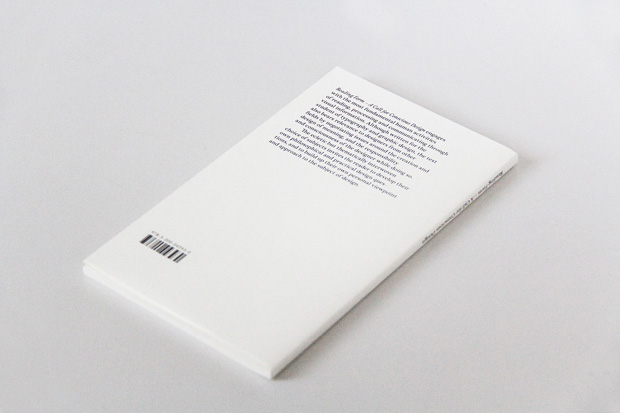
The extract published above comprises the Introduction and first chapter of:
Reading Form – A Call for Conscious Design
By Paulus Dreibholz
ISBN: 978-3-200-04393-0, 126 x 210mm (portrait), 56 pages, single colour throughout, Language: English (a German version is available under the title Formen Lesen – Ein Plädoyer für bewusste Gestaltung)
Find out more about Paulus's work here.

